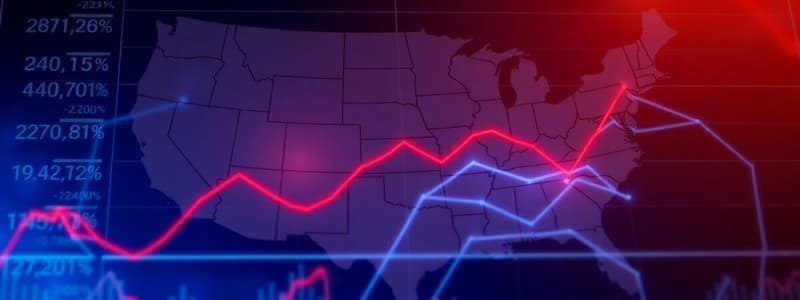Podcast
Questions and Answers
How long did it take the Federal government to accumulate its first trillion dollars of debt?
How long did it take the Federal government to accumulate its first trillion dollars of debt?
What was the rate at which the Federal government was borrowing money during the 1990s?
What was the rate at which the Federal government was borrowing money during the 1990s?
What does the term 'deficits' refer to in the context of government finances?
What does the term 'deficits' refer to in the context of government finances?
According to the information, what is the average annual interest payment per person for federal debt?
According to the information, what is the average annual interest payment per person for federal debt?
Signup and view all the answers
What is meant by the term 'national debt'?
What is meant by the term 'national debt'?
Signup and view all the answers
What is indicated as a consequence of the government's uncontrolled tax-and-spend policy in the 1980s?
What is indicated as a consequence of the government's uncontrolled tax-and-spend policy in the 1980s?
Signup and view all the answers
What do officials imply when they state that governments have no real wealth of their own?
What do officials imply when they state that governments have no real wealth of their own?
Signup and view all the answers
What is the approximate federal debt mentioned in the letter?
What is the approximate federal debt mentioned in the letter?
Signup and view all the answers
How long would it take to walk the length of $1 million in $100 bills laid end-to-end?
How long would it take to walk the length of $1 million in $100 bills laid end-to-end?
Signup and view all the answers
How many years would it take to walk the length of the federal debt in $100 bills?
How many years would it take to walk the length of the federal debt in $100 bills?
Signup and view all the answers
How many times would a line of $100 bills representing the federal debt circle the earth?
How many times would a line of $100 bills representing the federal debt circle the earth?
Signup and view all the answers
What significant economic event occurred during the 1990s in relation to federal debt?
What significant economic event occurred during the 1990s in relation to federal debt?
Signup and view all the answers
What triggered a significant spending spree in the economy during the 1990s?
What triggered a significant spending spree in the economy during the 1990s?
Signup and view all the answers
What action did federal officials begin by 2000 that impacted the money supply?
What action did federal officials begin by 2000 that impacted the money supply?
Signup and view all the answers
What historical event is compared to the stock market boom of the 1990s?
What historical event is compared to the stock market boom of the 1990s?
Signup and view all the answers
Study Notes
Federal Debt Overview
- Current federal debt: $6.783 trillion ($6,783,000,000,000)
- Understanding the debt size is as difficult as understanding the distances in our galaxy, due to its sheer magnitude.
- The debt, according to the author, has become so large that it's no longer considered "real" by many politicians.
Visualizing the Debt
- A million dollars in $100 bills laid end-to-end is about one mile long.
- The entire federal debt in $100 bills would stretch around the Earth 240 times and take 228 years to walk.
- Accumulating the current federal debt would have taken Columbus 20,000 dollars every minute since his arrival to the year 2000.
Debt Accumulation and Spending
- The author notes a significant increase in borrowing from the early 1980s, suggesting a decision to borrow "without limit", as a deliberate strategy.
- The US took 194 years to accumulate the first trillion, five years for the second, then a third by 1990, and the fourth by 1992, and now working on the seventh trillion.
- The 1990s saw the government borrowing at a rate of $1 million every two minutes.
Debt Implications and Solutions
- Annual interest payments on the debt are roughly $1,097 per person per year, or $4,388 per family of four.
- This pattern of borrowing is unsustainable - something has to change.
- Question is raised about how the government will repay the debt and interest.
- Government, according to the author, has no real wealth of its own; it relies on taking from others.
- Washington argues for prudent use of public credit to preserve it.
Roaring 90s Economic Factors
- The Federal Reserve injected $2.4 trillion into the economy during the 1990s.
- This injected money fueled a significant stock market boom, surpassing that of the 1920s.
- Increased stock market profits led to higher government tax revenues, reducing the need to borrow.
- This period saw a halt in the growth of the US government's debt.
- Strong sales, increased hiring, and reduced unemployment resulted from the period's economic conditions.
- By 2000, the federal government started slowing the rate at which money was injected into the economy.
- The stock market crashed, followed by the 2001 recession.
Key Economic Terminology
- Deficit: The difference between government spending and tax revenue (funded either by borrowing or printing money).
- Federal Debt: The accumulated total of all past federal deficits.
- National Debt: Another term that usually refers to Federal debt.
Studying That Suits You
Use AI to generate personalized quizzes and flashcards to suit your learning preferences.
Description
This quiz explores the staggering size of the federal debt, examining its implications on modern economics. It delves into the visualizations that illustrate the depth of this financial obligation and how borrowing behavior has evolved over the decades. Test your understanding of federal debt and its profound impact on the economy.




